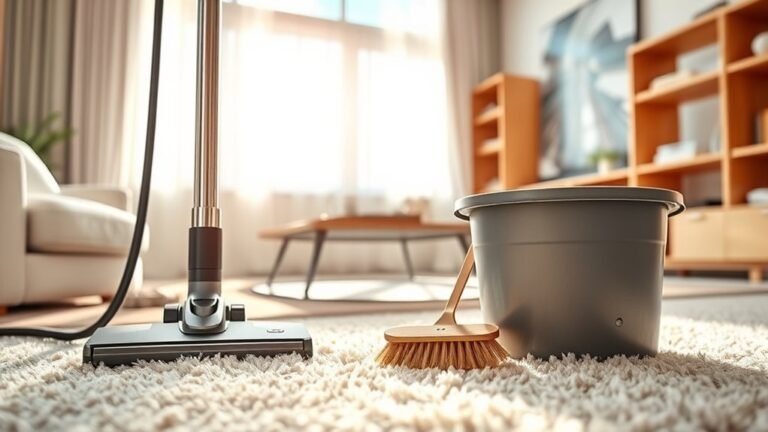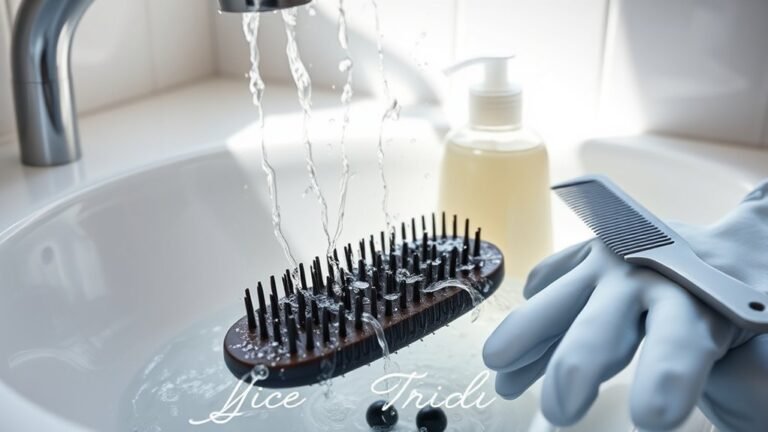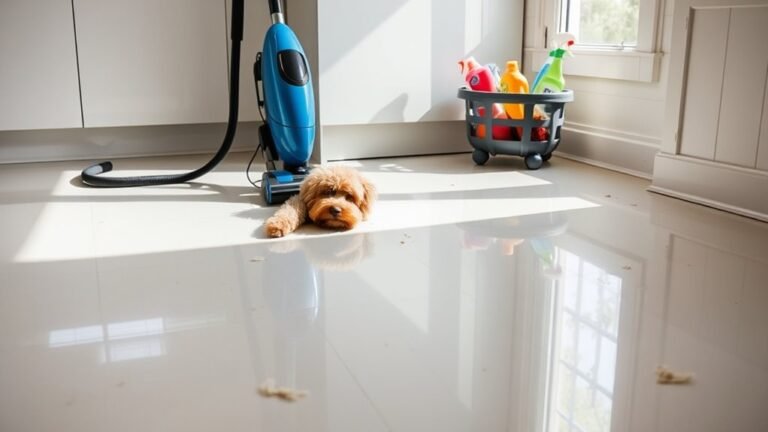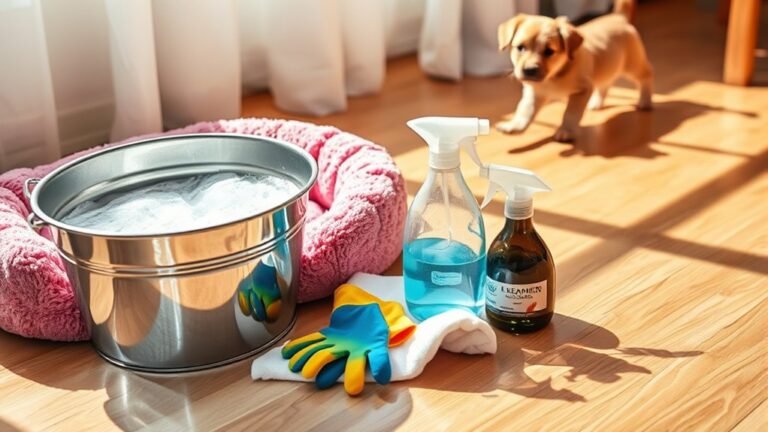How to Clean Your Home to Reduce Pet Allergens
To reduce pet allergens, vacuum your home frequently using a HEPA-filter vacuum and focus on high-traffic areas and pet favorite spots. Wash pet bedding and soft furnishings weekly with hypoallergenic detergent, and groom pets regularly to control dander. Use air purifiers with true HEPA filters placed strategically, and create pet-free zones like bedrooms to limit allergen spread. Proper cleaning and maintenance can ease your symptoms—there’s more you can do to make your home truly comfortable and allergen-friendly.
Understanding Common Pet Allergens in the Home

Pet allergens are tiny proteins found in your pet’s skin cells, saliva, urine, and dander that can trigger allergic reactions. When your pet sheds, these allergens spread throughout your home, settling on furniture, carpets, and clothing. Understanding common allergens like dander and saliva is key to gaining control over your environment. You don’t have to feel trapped by sneezing or itchy eyes; knowing where these allergens hide gives you the freedom to tackle them effectively. Pet shedding may seem unavoidable, but recognizing it as a source of allergens empowers you to create a cleaner, healthier living space. By becoming aware of these invisible irritants, you take the first step toward reclaiming your home’s comfort and your personal well-being.
Effective Vacuuming Techniques to Remove Pet Dander
Vacuuming your home thoroughly is one of the most effective ways to reduce dander buildup. To truly free your space from pet allergens, use vacuum attachments designed for tight corners, upholstery, and baseboards—these spots often hide stubborn dander. Don’t rush; slow, deliberate passes help lift allergens from carpets and floors. Regular carpet maintenance is key, so vacuum high-traffic areas daily and less-used spots at least twice a week. Choose a vacuum with a HEPA filter to trap dander instead of releasing it back into the air. By mastering these vacuuming techniques, you take control over your environment, creating a cleaner, allergen-reduced home where you can breathe freely and live without restrictions.
Choosing the Right Air Purifiers for Allergy Relief
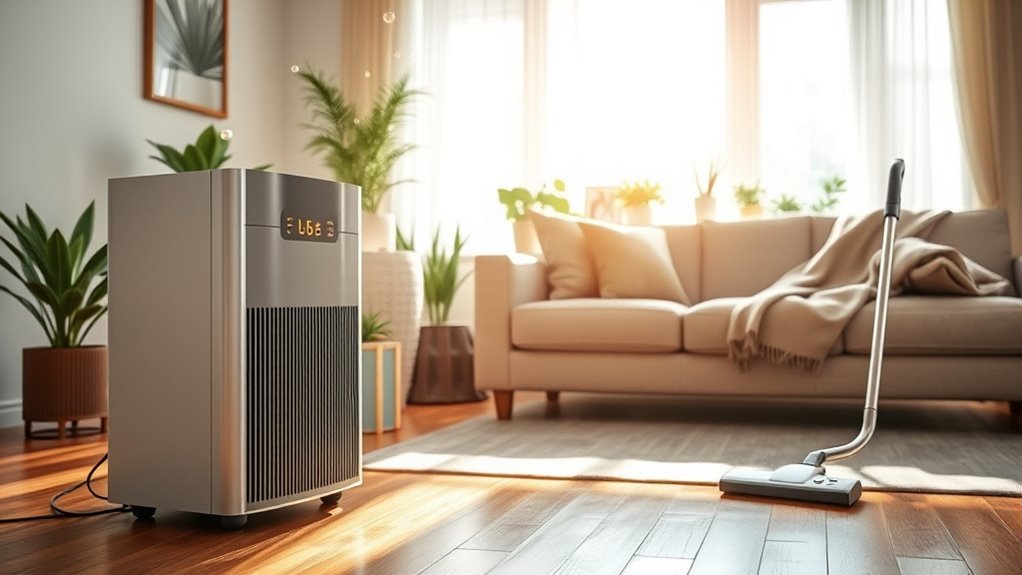
When picking an air purifier, make certain it has a true HEPA filter to effectively trap pet allergens. You’ll also want to place the purifier in the room where you spend the most time, ideally near your pet’s favorite spot. Proper placement guarantees you’re breathing cleaner air and getting the best allergy relief.
HEPA Filters Benefits
Air purifiers with HEPA filters can make a big difference in reducing allergens in your home. They trap tiny pet dander particles, improving your indoor air quality markedly. Knowing the different HEPA filter types helps you pick the one that suits your needs and lifestyle. Regular filter maintenance guarantees your purifier keeps working efficiently, so you can enjoy allergen-free air without hassle.
| HEPA Filter Types | Filter Maintenance Tips |
|---|---|
| True HEPA | Replace every 6-12 months |
| HEPA-Type (Less effective) | Vacuum pre-filter monthly |
| Washable HEPA | Clean filter gently as instructed |
Choosing wisely and maintaining your filter gives you freedom from constant allergy worries.
Room Placement Tips
Selecting the right HEPA filter is just one part of controlling pet allergens; where you place your air purifier can make a big difference in its effectiveness. To maximize relief, consider your room layout carefully. Position the purifier in high-traffic areas where pet dander tends to accumulate, like living rooms or bedrooms where your pet spends time. Avoid placing it behind furniture or tight corners, as poor furniture arrangement can block airflow and reduce the purifier’s efficiency. Ideally, place it centrally or near your breathing zone while sitting or sleeping. Keep pathways clear to allow free circulation of clean air throughout the room. By thoughtfully integrating your air purifier into the room layout and furniture arrangement, you create an environment that supports your freedom from allergens and breathes easier every day.
Washing Pet Bedding and Soft Furnishings Regularly
Washing pet bedding and soft furnishings at least once a week is essential to reduce allergens in your home. Different fabric types demand specific washing techniques to keep allergens at bay without damaging materials. For instance, cotton and polyester blends can usually handle hot water, while delicate fabrics like fleece need gentler cycles. Using hypoallergenic detergents helps maintain freedom from irritants.
| Fabric Type | Recommended Temperature | Washing Technique |
|---|---|---|
| Cotton | Hot (60°C/140°F) | Regular cycle |
| Polyester | Warm (40°C/104°F) | Gentle cycle |
| Fleece | Cold (30°C/86°F) | Delicate cycle |
Strategies for Cleaning Hard Surfaces and Floors

Keeping hard surfaces and floors clean is essential in minimizing pet allergens throughout your home. You want to focus on hard surface cleaning by wiping down countertops, tables, and other surfaces with a damp cloth regularly. This prevents pet dander from settling and spreading. For floor maintenance, vacuum daily using a vacuum with a HEPA filter to trap allergens effectively. Hard floors benefit from a damp mop to pick up dust and pet hair that vacuuming might miss. Avoid dry sweeping, which just stirs up allergens into the air. By sticking to these cleaning routines, you’ll maintain a fresher, freer space without the burden of lingering pet allergens, letting you enjoy your home with less sneezing and more peace of mind.
Managing Pet Grooming to Minimize Allergens
To keep pet allergens under control, you’ll want to establish a regular brushing routine to reduce loose fur and dander. Bathing your pet at the right frequency helps wash away allergens without irritating their skin. Also, choosing hypoallergenic grooming products can make a big difference in minimizing allergen buildup.
Regular Brushing Routine
Although managing pet allergens can feel overwhelming, establishing a regular brushing routine is one of the most effective ways to reduce dander and loose fur in your home. You’ll want to pick the right brushing tools tailored to your pet’s coat—whether it’s a slicker brush, comb, or deshedding tool. These tools help capture allergens before they spread around your space. Set a grooming schedule that fits both your lifestyle and your pet’s needs, aiming for consistency. Brushing even just a few times a week can make a noticeable difference, freeing your home from excess fur and dander. This simple habit gives you both freedom from constant cleaning and keeps your pet comfortable, creating a healthier environment for everyone.
Bathing Frequency Tips
Since pet allergens often cling to your furry friend’s coat, regular bathing is key to minimizing their spread around your home. You’ll want to follow proper bathing techniques to avoid irritating your pet’s skin while effectively removing dander and allergens. Frequency guidelines generally suggest bathing your pet every two to four weeks, but this can vary depending on your pet’s breed, activity level, and skin sensitivity. Bathing too often may strip natural oils, so stick to a consistent routine that balances cleanliness with comfort. Remember, a well-maintained bathing schedule not only helps reduce allergens but also keeps your pet happy and healthy. By mastering these bathing frequency tips, you’re taking an important step toward a freer, allergen-reduced living space.
Choosing Hypoallergenic Products
When managing pet grooming to reduce allergens, choosing hypoallergenic products can make a significant difference. You want to avoid harsh chemicals that irritate both your pet’s skin and your own respiratory system. Opt for hypoallergenic cleaning supplies that are free from strong fragrances and unnecessary additives. These products help keep your home fresh without triggering allergies. When washing your pet’s bedding or toys, use pet safe detergents designed specifically for sensitive skin. They’ll clean effectively while minimizing allergen buildup. By selecting gentle yet effective grooming products, you not only protect your pet but also maintain a healthier environment for yourself. This freedom from irritation lets you enjoy your furry companion without compromising your well-being or comfort.
Creating Allergen-Free Zones in Your Living Space
To reduce pet allergens in your home, you can create specific allergen-free zones where your pets aren’t allowed. Start by designating allergen free bedrooms, keeping doors closed to prevent dander from spreading. This gives you a personal sanctuary, free from pet allergens, where you can breathe easier and relax fully. Next, establish designated pet areas in your living space, like a cozy corner with their bed and toys. This keeps pet allergens contained and simplifies cleaning. Use easy-to-clean flooring in these zones to reduce allergen buildup. By setting clear boundaries, you maintain freedom in your home while minimizing allergen exposure. Creating these zones lets you enjoy your pets and your space, without compromising your health or comfort.
Frequently Asked Questions
Can Certain Pet Breeds Cause Fewer Allergy Symptoms?
When it comes to pet allergies, it’s not always a one-size-fits-all situation. You might find that hypoallergenic breeds, like Poodles or Bichon Frises, can be a refreshing change compared to others. These breeds tend to shed less dander, which means fewer allergy symptoms. Doing some breed comparisons can help you pick a pet that won’t tie you down with sneezing fits, letting you enjoy your freedom with furry friends.
How Often Should HVAC Filters Be Replaced to Reduce Pet Allergens?
You should replace your HVAC filters every 1 to 3 months to keep pet allergens at bay. Different filter types, like HEPA or electrostatic, capture allergens better, so choose one that fits your lifestyle. Don’t forget maintenance tips such as regular vacuuming around vents and checking filters for clogging. Staying on top of this lets you breathe easier and enjoy the freedom of a cleaner, allergen-reduced home without hassle.
Are Natural Cleaning Products Effective Against Pet Dander?
You might wonder if natural cleaning products really work against pet dander. Natural alternatives can be effective, but their cleaning efficacy often depends on the ingredients and how you use them. While they’re great for avoiding harsh chemicals and maintaining a healthy home, you’ll want to choose products with proven allergen-fighting properties or combine them with regular vacuuming and air filtration. This way, you keep your space fresh without sacrificing your freedom to choose greener options.
Does Humidity Level Affect Pet Allergen Presence in the Home?
When it comes to managing pet allergens, humidity control is the name of the game. You’ll find that keeping your home’s humidity between 30-50% can really help with allergen reduction, as too much moisture lets dander stick around like a bad penny. By mastering humidity control, you gain more freedom to enjoy your space without sneezing fits, making your home a haven where both you and your pets can thrive comfortably.
Can Diet Changes in Pets Reduce Allergen Production?
You might be surprised, but changing your pet’s diet can help reduce allergen production. Incorporating dietary supplements like omega-3 fatty acids can improve skin health, which lowers dander. Switching to hypoallergenic foods designed for sensitive pets can also cut down allergens by reducing irritation. It’s a simple way to give your furry friend freedom from discomfort while making your home more allergy-friendly—everyone wins without feeling restricted.

